Hernia Repair
What is a hernia?
Here is a picture of some of the most common hernias:
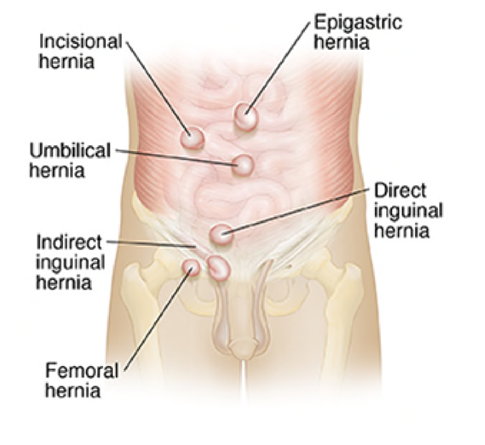
Is a hernia serious?
Some hernias are small and cause no symptoms at all. Other hernias can cause symptoms like pain, weakness, and bulging. A hernia that has no symptoms can become more serious over time. If the bulging tissue gets stuck in the hole that it is pushed through and gets stuck (“incarcerated”), it can cause the blood supply to be cut off from the tissue or organ (“strangulated”). This can cause tissue death and needs medical attention.
Incarcerated Hernia
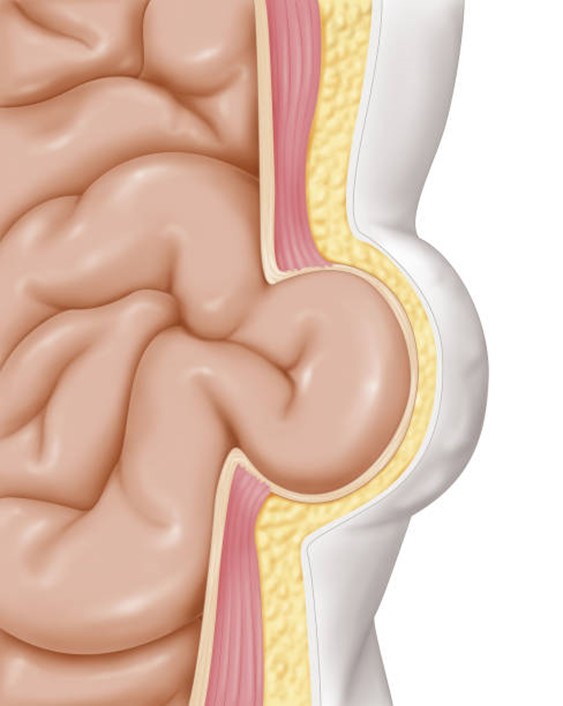
Strangulated Hernia
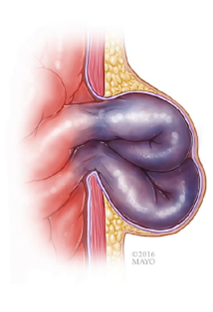
How is hernia repair surgery done?
Hernia repair surgery is common and is usually considered a minor procedure. During the surgery, your doctor will push the herniated tissue back into place and repairs the area it came out of with stiches or surgical mesh. There are several options for hernia repair: Some hernia repair is done using traditional open surgery with larger incisions, but most often, hernia repair can be done using minimally invasive surgery. Minimally invasive techniques means that the incisions will be smaller so there is less postoperative pain and a faster recovery.
Traditional open surgery: The surgeon makes an incision over the hernia and opens the area needing repair.
Laparoscopic surgery
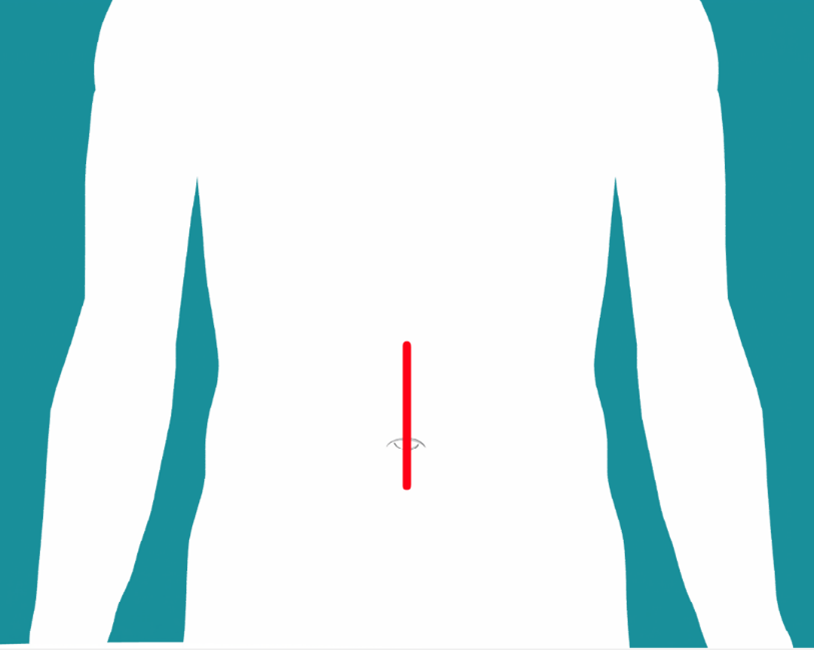
A long, thin tube with a camera on the end, called a laparoscope goes into a very small incision. Long, thin surgical tools go into a different incision.
Robotic surgery
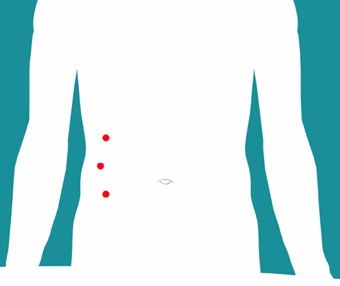
This is similar to laparoscopic surgery, but the doctor controls the surgical tools from a computer console, using robotic arms.
What should I expect after surgery?
After the surgical repair of your hernia, you can expect to have some pain for several days, with discomfort that can last up to two weeks. You may also feel more tired than usual. This is normal. Most people feel much better after 7 days.
You may have some swelling/bruising in the scrotal area after inguinal hernia repair, or at the incision sites for any surgery. This is not uncommon and will resolve with time.
You may feel occasional “twinges and pulls” at the incision sites or where your hernia was. This is normal during the healing process.
You may develop a seroma or hematoma in the space where your hernia was before surgery. This is a collection of either serous fluid or blood that fills in the space where the hernia used to be. The seroma/hematoma can sometimes look like a bulge, as if the hernia has returned. This is normal and usually resolves within 3 months of surgery. If you develop one, be sure to discuss this with your surgeon at your postoperative appointment.
Depending on the size of the hernia repair, you may be given an abdominal binder to wear for support and comfort until you return for postoperative appointment. If you are given an abdominal binder, you may remove it to shower. You may also remove it if it is causing discomfort.
You will have a weight restriction, meaning you will be asked not to lift heavy objects for a period of time. Most hernia repairs have a weight restriction of 10 pounds for 4 weeks. Robotic INGUINAL hernia repair has a weight restriction of 10 pounds for 2 weeks. If you have a different weight restriction, your surgeon will discuss this will you before you leave the recovery room.
Some patients experience problems with constipation after surgery. If you believe this may happen, you can take an over-the-counter stool softener as a preventative measure when you get home from surgery. You may take this daily until you feel you no longer need it. If you have not had a bowel movement by post-op day 5 (the day after your surgery is post-op day 1), take a laxative like Miralax or Milk of Magnesia and use as directed on the bottle.
You will be able to drive once you are off all narcotic pain medication and you can safely maneuver the vehicle without discomfort.
Easing post-procedural symptoms
In the first 24-48 hours after surgery, wrap an ice pack in a towel (to protect your skin) and apply it to incision sites or to swollen/bruised areas. Do not leave ice on your skin for longer than 20 minutes (20 minutes on , 40 minutes off every hour as needed).
On Post-op day 3 (the day after your surgery is post-op day 1), you may begin to use a warm (not hot) heating pad to help with the muscular discomfort. Always protect your skin with a towel and do not leave heat on the area for an extended period of time.
Over-the-counter pain relievers like ibuprofen or acetaminophen (Tylenol) work well for postoperative pain. Do not take these medications if you have other health conditions that restrict you from using them.
Walk! Walking eases discomfort and helps blood flow to your tissues to help with healing. As long as you stay within your restricted weight limits, you should be moving around, going up-and-down stairs, and living as normal as you are able.
Dressings
- Your surgical incision has either (purple) surgical glue, clear plastic (Tegaderm), or paper strips (Steri-strips) over it. It is ok to shower 24 hours after the surgery. While in the shower, DO NOT scrub the dressing. Instead, allow clear water to flow over it and gently pat it dry with a clean towel.
- Surgical glue may peel off on its own between 7 and 10 days after surgery. If the glue is still on at your postoperative appointment, we will have you peel if off then.
- Steri-strips may begin to curl and loosen on their own. If this happens, it is normal. Leave them alone and do not remove them until between 7 and 10 days after surgery.
- If you have a Tegaderm (clear) dressing, you may remove it 48 hours (2 days) after surgery, unless your surgeon has given you instructions otherwise.
- DO NOT soak in a tub, pool, spa, or any body of water until you are seen by the surgeon at your postoperative appointment.
When to call NL Surgical Specialists at 207-973-8881
- You have new drainage, or the swelling/redness at your incisions are increasing, rather than decreasing.
- You are unable to pass gas and have increased pain.
- You have been unable to void after the time that was specified when you were discharged from the recovery room.
- You feel a “pop” at the surgery site and feel something moving in-and-out. This could mean a stitch has released. While this is not an emergency and usually requires no intervention, we would like you to let us know so we can assess the wound for proper healing.
- You develop nausea, fever (over 100.5), chills, or body aches.
- You have other, urgent symptoms you think may be related to the procedure and need to speak with a doctor.
- You experience new or worsening symptoms.
Seek immediate medical attention (call 911 or go to the nearest emergency department) if:
- You have heart racing or have severe trouble breathing
- You have sudden chest pain and shortness of breath, or you cough up blood
- You have any other symptoms you believe are a medical emergency.
- If you are being treated at a hospital that is NOT NL EMMC, ask that hospital to contact our NL Transfer Center at 207-973-9000.
- Contact NL Surgical Specialists at 207-973-8881 to tell us if you are seeking care at any Emergency Department, including NL EMMC.
There is more to know about having a procedure at Northern Light Eastern Maine Medical Center!
To find out how to prepare and what to expect at on the day of your procedure, including information about having and recovering from anesthesia, visit Surgical Education homepage.